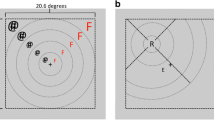Abstract.
'Inhibition of return' (IOR) refers to the delayed detection often found for targets at the same location as a preceding event. We examined whether IOR reflects a truly supramodal phenomenon, in an experiment designed to avoid criticisms of previous crossmodal research. We presented a random sequence of visual, tactile, and auditory targets to either the left or right of central fixation, and tested for IOR between targets in all three modalities when presented successively to the same versus different side. Speeded detection for targets in all three modalities was indeed slower if the preceding target had been presented from the same position, regardless of the modality of this preceding target. These results demonstrate for the first time that IOR is truly supramodal.
Similar content being viewed by others
Author information
Authors and Affiliations
Additional information
Electronic Publication
Rights and permissions
About this article
Cite this article
Spence, C., Lloyd, D., McGlone, F. et al. Inhibition of return is supramodal: a demonstration between all possible pairings of vision, touch, and audition. Exp Brain Res 134, 42–48 (2000). https://doi.org/10.1007/s002210000442
Received:
Accepted:
Issue Date:
DOI: https://doi.org/10.1007/s002210000442




